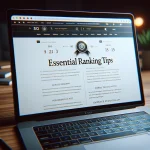Table of Contents

Key Takeaways
- A well-crafted blog post aligns with SEO best practices to enhance search engine visibility.
- Identifying and understanding your target audience is crucial for creating relevant and engaging content.
- Effective keyword research and integration are key to improving your blog’s SEO performance.
- Structuring your blog with proper tags, readable format, and optimized images boosts SEO.
- High-quality, authentic content not only attracts but also retains readers, enhancing SEO through engagement.
Imagine you’ve just opened a new bookstore. You’ve got great books and a cozy space, but no one walks in because they can’t find you. That’s what happens when your blog isn’t optimized for search engines. Your content might be award-worthy, but without SEO, it’s like a hidden gem that no one will discover. Let’s make sure that doesn’t happen. Here’s how to craft blogs that align with SEO best practices, ensuring your content gets the spotlight it deserves.
Unlocking SEO Potential Through Effective Blogging
“To master SEO, think like a librarian. Just as a librarian organizes books to help visitors find what they’re looking for, your job is to organize your content to help search engines and readers find your blog.”
SEO is the art and science of making your blog easy to find, easy to crawl, and easy to categorize. It’s about helping your readers find you from among thousands of other websites. SEO-friendly content is the key to opening the floodgates of traffic to your blog.
But what is SEO-friendly content? It’s not just about using keywords or having the right meta tags. It’s about creating content that is useful, informative, and engaging. It’s about writing for humans, not just search engine algorithms. That’s where the true magic happens.
Core Principles of SEO-Friendly Content
SEO-friendly content serves two masters: the reader and the search engine. A balancing act, yes, but not a tightrope walk. It’s about understanding what your readers are searching for and how search engines work. This synergy leads to content that resonates with both parties.
Significance of Tailoring Content to Search Algorithms
Search engines are becoming smarter, but they still need our help. They use algorithms to determine the relevance and quality of your content. By tailoring your content to these algorithms, you’re more likely to rank higher in search results. This means more eyes on your work and more potential for engagement and conversion.
Most importantly, don’t write for algorithms at the expense of your readers. Your primary goal is to provide value to your audience. Do that well, and the algorithms will follow.
Identifying Your Target Audience
Before you write a single word, you need to know who you’re writing for. Who are the people that are going to be interested in your content? What are their needs, their pain points, their desires? Understanding your audience is the first step in creating content that they will find valuable and engaging.
Think about your ideal reader. What are they looking for when they come to your blog? Are they seeking advice, information, products, or services? When you know what your audience wants, you can create content that draws them in.
The Role of Buyer Personas in Content Creation
Buyer personas are fictional, generalized representations of your ideal customers. They help you understand your audience better and make it easier for you to tailor content to the specific needs, behaviors, and concerns of different groups.
Creating detailed buyer personas is not just beneficial, it’s necessary. It guides your content strategy and ensures that everything you write is crafted with a specific person in mind.
Gauging Audience Needs and Interests
Once you have your buyer personas, it’s time to dig deeper. Use tools like surveys, social media listening, and analytics to understand what your audience is talking about, what questions they have, and what kind of content they’re seeking. This insight allows you to create content that hits the mark every time.
This article at a glance … “Crafting Blogs That Align with SEO Best Practices” in a table format:
| Topics | Subtopics |
|---|---|
| Importance of SEO in Blogging | – Understanding the basics of SEO |
| – Incorporating relevant keywords into content | |
| – Crafting compelling meta descriptions and URLs | |
| – Optimising blog posts for better visibility and higher rankings on search engines | |
| Structuring Blog Posts for SEO | – Creating engaging outlines |
| – Incorporating images and alt text | |
| – Finding a unique writing style | |
| – Understanding the basics of SEO | |
| – Ensuring readability and user-friendliness | |
| – Internal linking, URL structure, and image optimisation | |
| Measuring and Improving SEO Content | – Tracking performance with analytics tools |
| – Improving content based on insights and data |
Citations:
[1] https://wsidigitaladvisors.uk/how-to-craft-blogs-that-rank-in-google/
[2] https://seowind.io/how-to-optimize-blog-post-for-seo/
[3] https://www.fireandspark.com/blog/writing-for-seocrafting-content-for-search-engines/
[4] https://aicontentfy.com/en/blog/art-of-crafting-seo-optimized-content-best-practices-and-strategies
[5] https://strategically.co/blog/content-marketing/how-to-write-blog-post/
Keyword Mastery for Improved Visibility
Keywords are the signposts that guide users to your content. They’re the terms and phrases that people type into search engines when they’re looking for information. Your job is to understand which keywords are relevant to your audience and to use them in a way that feels natural and helpful.
Using the right keywords can make the difference between your blog showing up on the first page of search results or getting lost in the depths of the internet. It’s about being seen by those who are looking for what you have to offer.
Research Tools and Strategies for Keyword Identification
Keyword research is not a guessing game. There are tools designed to help you find the right keywords. Tools like Google’s Keyword Planner, SEMrush, and Ahrefs provide insights into search volume, competition, and even keyword relevance. It’s all about finding the sweet spot of high search volume and low competition.
Once you’ve identified your keywords, the next step is integrating them into your blog content. This doesn’t mean stuffing your posts with keywords to the point where it’s unreadable. Instead, it’s about weaving them into your content in a way that feels organic and enhances the reader’s experience.
Remember, the goal is to create content that is both informative and enjoyable to read. Keywords are just one piece of the puzzle.
And don’t forget about long-tail keywords. These are longer, more specific phrases that are less competitive and often have a higher conversion rate. They’re like the secret passages that lead readers directly to your content.
Use your keywords in the title, headings, and throughout the body of your post. But always keep the reader’s experience in mind. If it doesn’t make sense or feels forced, don’t include it.
Let’s pause here. In the next section, we’ll dive into how to structure your blog for the best SEO impact and how to create high-quality content that engages your audience. Stay tuned.
Implementing Header Tags and Bullet Points for Readability
Now, let’s talk structure. Good structure isn’t just for buildings; it’s essential for blog posts too. Header tags, like H1s for your title and H2s or H3s for your subheadings, help break down your content into digestible chunks. Not only does this make your post more readable for your audience, but it also makes it easier for search engines to understand what your content is about.
- Use H1 tags for your main title only. This is what tells search engines, “Hey, this is what my content is really about.”
- Break up your content with H2 and H3 tags for subheadings. This not only adds visual appeal but also gives search engines more context.
- For lists, bullet points are your friends. They’re perfect for summarizing information and keeping your content neat and tidy.
Subheadings are like signposts on a highway; they guide the reader through your content. They’re also a great place to include your keywords, but remember to keep it natural. Forcing keywords where they don’t belong will do more harm than good.
And bullet points? They’re like the snacks of the reading world – small, easily digestible bits of information that keep your readers engaged. Use them to highlight key points, features, benefits, or steps in a process.
Optimizing Images and Multimedia
- Choose relevant, high-quality images that complement your content.
- Use alt text to describe your images – this helps search engines understand what the image is and how it relates to your content.
- Keep file sizes small to ensure your page loads quickly, which is a key ranking factor for SEO.
- Consider using infographics or videos to explain complex topics or to add a new dimension to your content.
Images and multimedia not only add life to your blog but also provide a break from text. They can explain concepts more clearly than words alone and are more likely to be shared on social media, which can help increase your post’s reach.
But here’s the catch: search engines can’t “see” images the way we do. That’s why you need to tell them what the images are about using alt text. Think of alt text as a caption that search engines read to understand the image’s context and relevance.
Moreover, oversized images can slow down your page load time, which can frustrate readers and hurt your SEO. So, always optimize your images for the web.
And when it comes to multimedia like videos or infographics, they can make complex information more accessible and engaging. Just make sure they’re also optimized for SEO with descriptive titles and file names.
Internal Linking to Strengthen Website Structure
Think of your website as a city and your links as roads connecting different places. Internal linking helps search engines crawl your site and understand the relationship between various pages. It also keeps readers engaged by providing them with additional relevant content to explore.
When you link to other pages on your site, you’re essentially saying, “If you liked this, you’ll love this too.” It’s a way of keeping your readers on your site longer, reducing bounce rates, and increasing the chances of conversion.
Most importantly, use descriptive anchor text for your internal links. Instead of “click here,” use text that describes what the reader will find when they follow the link. This not only improves user experience but also helps search engines understand what the linked page is about.
Mobile-First Approach in Blog Design
In today’s world, if your blog isn’t mobile-friendly, you’re missing out on a huge chunk of potential readership. Search engines like Google prioritize mobile-friendly websites in their rankings. Therefore, adopting a mobile-first design is not just a good idea; it’s imperative.
Mobile-first means designing your blog with mobile users in mind before making it compatible with desktop computers. It’s about ensuring that your content looks good and is easy to navigate on a smaller screen.
So, test your blog on various devices, keep your design simple and responsive, and always consider the user’s experience. If they can’t read your blog comfortably on their phone, they’re likely to move on to one they can.
Creating High-Quality Content That Engages
Content is king – you’ve heard it a thousand times because it’s true. High-quality content is what will set your blog apart from the millions of others out there. It’s what will make your readers come back for more. But what exactly makes content “high-quality”?
High-quality content is informative, engaging, and provides value to the reader. It’s well-researched and well-written, with a clear purpose. It’s the kind of content that answers questions, solves problems, or provides insights that the reader can’t find anywhere else.
And here’s the kicker: great content is what gets shared. The more your content is shared, the more backlinks it earns, and the better it will rank in search engine results.
Example: Let’s say you’re writing a blog post about healthy eating. A high-quality post might include a mix of personal anecdotes, scientific research, practical tips, and perhaps a recipe or two. It’s the kind of content that provides a comprehensive look at the topic and leaves the reader feeling educated and empowered.
Fostering Authenticity and Trust With Your Readers
Your readers are smart. They can spot a fake from a mile away. Authenticity is what builds trust, and trust is what turns a one-time reader into a loyal follower. Share your experiences, be transparent about your knowledge and limitations, and always strive to be genuine in your writing.
Trust also comes from consistency. If you say you’re going to post every week, make sure you post every week. If you’re providing advice, make sure it’s advice that you would follow yourself. Your readers will appreciate your reliability and come to see you as a trusted source of information.
Encouraging Audience Interaction and Shares
Engagement is a two-way street. You want your readers to interact with your content, whether it’s by leaving comments, sharing your posts, or even just clicking on a link. But to get them to do that, you need to provide them with content that they find valuable and engaging.
Ask questions at the end of your posts to encourage comments. Include share buttons to make it easy for readers to spread the word. And most importantly, be responsive. When someone takes the time to comment on your blog, take the time to reply. It shows that you value their input and are engaged with your audience.
Monitoring and Adapting to SEO Trends
SEO is not a set-it-and-forget-it kind of deal. It’s an ever-evolving field, with search engines constantly updating their algorithms. To stay ahead of the game, you need to be vigilant and adaptable.
Keep an eye on your analytics to see what’s working and what’s not. Pay attention to SEO news for updates on algorithm changes. And most importantly, be willing to adapt your strategy as needed. The world of SEO is always changing, and your tactics need to change with it.
By following these best practices, you’re setting your blog up for success. But remember, SEO is a marathon, not a sprint. It takes time, effort, and a lot of patience. Keep at it, and you’ll see your blog climb the search engine rankings, attract more readers, and achieve the recognition it deserves.
Monitoring your blog’s performance is not just about celebrating the wins; it’s about understanding and leveraging the data to make informed decisions. Regularly checking your analytics will show you which posts are performing well, where your traffic is coming from, and what your audience is engaging with the most. This data is invaluable because it tells you more about your audience’s behavior and preferences, allowing you to tailor your future content accordingly.
For instance, if you notice that posts about a particular topic are getting more views and shares, it might be worth creating more content in that area. Conversely, if certain posts are consistently underperforming, it might be time to either improve them or pivot your strategy.
Monitoring and Adapting to SEO Trends
SEO is not static; it’s a field in constant flux, influenced by changes in technology, search engine algorithms, and user behavior. Staying current with these changes is essential for maintaining and improving your blog’s search engine rankings.
Tracking Performance and Making Data-Driven Decisions
Use tools like Google Analytics, Google Search Console, and keyword tracking software to monitor your blog’s performance. Look at metrics such as page views, bounce rate, time on page, and conversions to gauge the success of your content and SEO strategies. Use this data to inform your decisions and make adjustments to your blog’s content and SEO tactics.
Keeping Up With Algorithm Updates and Industry Changes
Search engines like Google frequently update their algorithms to provide users with the most relevant and high-quality search results. As a blogger, it’s crucial to stay informed about these updates and understand how they might affect your site’s ranking. Follow SEO news sources, attend webinars, and participate in online forums to keep abreast of the latest trends and best practices in SEO.
Frequently Asked Questions (FAQ)
How Often Should I Update My Blog for SEO?
Consistency is key in blogging. Ideally, you should aim to update your blog with fresh content at least once a week. Regular updates signal to search engines that your site is active and providing new information, which can help improve your rankings. However, quality should never be sacrificed for the sake of frequency. It’s better to publish one excellent post per week than several mediocre ones.
What’s the Ideal Blog Post Length for Good SEO?
While there’s no one-size-fits-all answer, a good rule of thumb is to aim for posts that are at least 300 words long. However, longer, in-depth posts of 1,000 to 2,000 words tend to perform better in search rankings. The key is to ensure that the length is justified by the value of the content provided. Quality, comprehensive content that satisfies user intent is more important than word count alone.
Example: A detailed guide on ‘How to Start a Vegetable Garden’ may require 2,000 words to cover all the necessary steps and tips, while a brief update on ‘The Best Seasonal Vegetables for Your Garden’ may only need 500 words to be effective.
How Do I Know If My Blog is SEO-Friendly?
An SEO-friendly blog has clean, organized code, fast loading times, is mobile-responsive, and contains well-structured content with appropriate use of keywords. Tools like Google’s Mobile-Friendly Test and PageSpeed Insights can help you evaluate your blog’s performance. Additionally, an SEO-friendly blog will gradually see an increase in organic traffic and improved search engine rankings.
Can I Improve SEO With User-Generated Content?
Yes, user-generated content such as comments, reviews, and guest posts can enhance your SEO efforts. This type of content can increase the freshness of your site, provide more keywords, and encourage community and engagement. However, it’s important to moderate this content to ensure it’s high-quality and relevant to your blog.
Why Are Backlinks Important for Blog SEO?
Backlinks, which are links from other websites to your blog, are crucial for SEO because they act as votes of confidence from other sites. They signal to search engines that others find your content valuable and trustworthy, which can improve your blog’s authority and rankings. Aim to acquire high-quality backlinks from reputable sites in your niche to boost your SEO efforts.
By now, you should have a solid understanding of how to craft blogs that align with SEO best practices. Remember, it’s about creating valuable content for your readers, using the right keywords, structuring your posts for readability, and staying up-to-date with SEO trends. With these strategies in hand, you’re well on your way to enhancing your blog’s visibility and reaching a wider audience.






